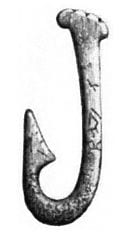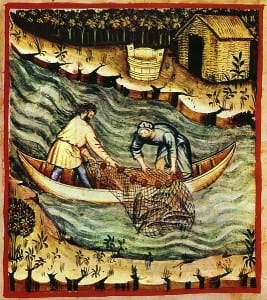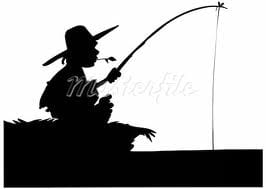 By Ed Snyder/Outdoors
By Ed Snyder/Outdoors
Since man first decided to catch and eat swimming critters of the sea they either chunked stones or threw makeshift spears to catch their supper. Fast forward a few years and man’s tools evolved into fishing rods with stones morphing into fishing tackle for catching those swimming critters.
Not much has really changed since the stone-ages as we’re still whittling those makeshift fishing spears and tools for improving our methods for catching swimming critters.
In my earlier beginnings I of ten raided my moms silverware drawer to hammer out fishing spoons, that is until mom took to paddling my fanny in order to save her heirlooms. Those paddlings had me whittling chunks of wood after that, forming objects resembling what those swimming critters were feeding on.
ten raided my moms silverware drawer to hammer out fishing spoons, that is until mom took to paddling my fanny in order to save her heirlooms. Those paddlings had me whittling chunks of wood after that, forming objects resembling what those swimming critters were feeding on.
My first crude attempts went fish-less. Seems that those carvings resembled something other than what the fish recognized as food. But many attempts later I finally carved a winner, taking a few nice bass on my “creepy crawler plug” as I called it. My younger years as an angler were spent switching from live bait to artificial lures. But as I aged older, and wiser, my options turned back to the artificial option.
Over my many angling years I’ve noticed the changes in the sport-fishing industry from wood to plastics to those surreal soft plastics that look more like the real thing than the real things do.
This has developed into a highly competive industry that would make a great spy movie, complete with all the drama that goes with it. Milions of dollars are spent every year in the international lure trade from Idea to development to testing to production and sales. But just how did we get to this point?
Fishing has become a sport for catching freshwater or saltwater fish, usually with rod, line, and hook, mainly as a way of providing food for survival. Fishing, as a sport however, has it’s ancient origin .
Egyptian angling came on the scene about 2000 BC showing figures fishing with rod, line and nets. Chinese in the 4th century BC referred to fishing with a silk line, a hook made from a needle, and a bamboo rod, with a ball of cooked rice as bait. References to fishing is also found in ancient Greek, Assyrian, Roman, and Jewish writings.
Today, fishing, often called sport fishing, distinguishing it from commercial fishing, is one of man’s principal relaxations and is, in many countries, the most popular outdoor recreational sport.
Man’s earliest fishing tools was the predecessor of the fishhook, a gorge: a piece of wood, bone, or stone an inch in length, pointed at both ends and secured off-center to the line. The gorge was covered with bait. When a fish swallowed the gorge, a pull on the line wedged it across the gullet of the fish, which then was pulled in by the angler.
 With the discovery of metals, the hook was one of the first tools made for fishing. It was attached to a hand-line made of animal or vegetable material. The practice of tying line to a rod, at first probably a stick or tree branch, made it possible to fish from the bank or shore giving man a common fishing tool still used today. For ions, the fishing rod was only a few feet in length. The earliest reference to a longer, jointed rod came from the Roman’s at about the 4th century AD. At that time the Macedonians were catching trout on artificial flies. The rod they used was 6 feet long with the line being the same length. The method used was probably gently laying the bait on the surface, much like our roll-casting method of today.
With the discovery of metals, the hook was one of the first tools made for fishing. It was attached to a hand-line made of animal or vegetable material. The practice of tying line to a rod, at first probably a stick or tree branch, made it possible to fish from the bank or shore giving man a common fishing tool still used today. For ions, the fishing rod was only a few feet in length. The earliest reference to a longer, jointed rod came from the Roman’s at about the 4th century AD. At that time the Macedonians were catching trout on artificial flies. The rod they used was 6 feet long with the line being the same length. The method used was probably gently laying the bait on the surface, much like our roll-casting method of today.
The first of great improvements came about the mid-17th century, when Izaak Walton and Charles Cotton were writing the classic ‘The Complete Angler, describing new tackle and methods of fishing.
About this time an unknown angler attached a wire loop at the tip of the rod, which allowed running fishing line through it, useful for both casting and playing a hooked fish.
In 1667 a salmon-fishing line of 26 yards was used. What was obviously needed was a means of taking up and holding such lengths of line, and this led to the invention of the fishing reel.
Experiments with material for the line led to the use of animal gut string. The use of a landing hook, now called a gaff, for lifting large hooked fish from the water was noted in 1667.
Improved methods of making fishhooks were forged in the 1650s by Charles Kirby, who later invented the Kirby bend, a distinctive shaped hook with offset point that is still common today.
The first basic reel consisted of a wooden spool with a metal ring that fitted over the angler’s thumb. By 1770 a rod with guides for the line along its length and a reel was in common use. The first true reel was a geared reel attached under the rod, in which one turn of the handle moved the spool several revolutions, invented by two Kentucky watchmakers in the early 1800s.
Fishing rods were improved using heavy native woods, replaced by straight-grained, tough, elastic woods, such as lance-wood and green-heart from South America and the West Indies, and by bamboo.By the end of the 18th century a technique had been developed in which several strips of bamboo were glued together, retaining the strength and pliancy of the cane but greatly reducing the thickness. Between 1865 and 1870 complete hexagonal rods, made by laminating six triangular strips of bamboo, were being produced and used by anglers on both sides of the Atlantic.
From 1880 tackle design evolved rapidly. Horsehair for fishing line was replaced by silk covered with coats of oxidized linseed oil. Such lines were easily cast and sank heavily if ungreased, or floated if greased. The average angler could cast three times farther with these lines, and such methods as dry-fly and wet-fly fishing became possible. In the Nottingham reel, ebonite (a hard rubber) or metal replaced wood, so that it became even more free-spinning. Since the reel revolved faster than the line runoff, a considerable tangle (called an overrun in Britain, a backlash in the U.S.) would result.
Controllers were devised to prevent this. In 1896 William Shakespeare, of Kalamazoo, Mich., devised the level-wind, which automatically spread the line evenly as it was wound on the reel. In 1880 the firm of Malloch, in Scotland, introduced the first turntable reel, which had one side of the spool open. During casting, the reel was turned 90º, bringing it in line with rod guides, so that the line slipped easily off the end of the spool. For line recovery, the spool was turned back 90º. The reel was used mainly for casting heavy lures for salmon fishing, but it influenced the reel invented by the English textile magnate Holden Illingworth, which the British called a fixed-spool reel and the Americans a spinning reel. In this kind of reel, the spool permanently faces up the rod and the line peels off in the cast as with the Malloch reel.
In the 20th century, rods became lighter without sacrificing strength. Split bamboo was largely replaced by fiber glass and finally by carbon fiber as rod material. The fixed-spool reel was invented after World War II, creating a boom in spin casting. Nylon monofilament line was developed in the late 1930s and became dominant after World War II, as did braided lines in other synthetic materials. Plastic coverings for fly lines allowed them to float or sink without greasing. Plastic also became the dominant material for artificial casting lures.
The four basic methods of angling are bait fishing, fly fishing, bait casting or spinning, and trolling. All are used in both freshwater and saltwater, but the first and last are most commonly used in saltwater.
Bait fishing, is certainly the oldest and most used method. A bait is impaled on a hook, which is set by the angler when the fish swallows it. Common baits then were worms, maggots, small fish, bread dough, or cheese. The bait was fished on the bottom, weighted down with what is called a sinker, made of lead, and fished on the bottom. A buoyant object, called a float or bobber made of quill, cork, wood, plastic, helped to suspend the bait at a desired depth.
In order to attract fish, ground bait called chum, was tossed in the water. Chum is commonly soaked bread or meal, to which some of the bait being used on the hook was added.
In North America, where the fish were predatory, still fishing is practiced with less specialized tackle, the traditional rod being a long cane pole. Freshwater fish taken by this method include pike, muskellunge, bluegill, crappie, perch, catfish, as well as bass or walleye.
 Ice fishing through holes cut in frozen lakes is particularly popular in the northern United States and the Great Lakes-St. Lawrence Valley region of the U.S. and Canada. Equipment is commonly a three-foot rod with a simple reel or a cleat-like device to hold nonfreezing monofilament line and a tilt or tip-up to signal when the fish has taken the bait. Fish taken vary from pan fish (crappies, bluegills, and perch) to larger game fish (pike, walleye, bass, and lake trout). Ice fishing became increasingly popular in the 20th century where heavy freezing permits it.
Ice fishing through holes cut in frozen lakes is particularly popular in the northern United States and the Great Lakes-St. Lawrence Valley region of the U.S. and Canada. Equipment is commonly a three-foot rod with a simple reel or a cleat-like device to hold nonfreezing monofilament line and a tilt or tip-up to signal when the fish has taken the bait. Fish taken vary from pan fish (crappies, bluegills, and perch) to larger game fish (pike, walleye, bass, and lake trout). Ice fishing became increasingly popular in the 20th century where heavy freezing permits it.
Fly fishing is considered by those who use the method to be the highest form of angling, and dry-fly fishermen consider themselves to be the true aristocracy of angling.
Fly fishing involved originally the use of live flies, and its art was to lay the fly as lightly and obtrusively near a fish, usually trout, as possible. Artificial flies came into use early, however, and live flies are only used in the periods when the winged forms are emerging from their aquatic nymph stage.
Wet-fly fishermen present flies underwater. Later variants include nymph fishing, in which the artificial fly resembles the waterborne form of the insect, and streamer fishing, in which the streamer gives to the fly a fish-like look.
The rods for both types of fly fishing are 7-10 feet long. The line is tapered toward the end nearest the fly and is of fairly heavy weight; this makes the casting of the line easier, since the fly itself is virtually weightless. A simple reel is used only to contain the line and to help in playing a hooked fish.
Species fished for were first trout and salmon, but by the second half of the 20th century virtually all game fish, fresh or saltwater were fished for with flies or light artificial baits.
Bait casting and spin casting differ essentially only in the type of reel used and the rod length.
Spinning rods are generally 7-10 feet long, while the usual length of a bait casting rod is 5-6 feet. As with fly fishing, bait casting originally used live minnows but grew to use lures in imitation of fish (sometimes crippled fish), as well as metal spoons and spinners.
Bait Trolling involves the use of live bait or artificial lures that are drawn through the water behind a slow-moving boat, originally rowed but now generally motor-powered.
Trolling is usually done inland on freshwater lakes or reservoirs, but it is also the primary method for big-game fishing in the oceans. This method has the advantage of covering large amounts of territory where fish might be difficult to locate.
The correct depth and speed are crucial in this method. The introduction of sonar equipment in the second half of the 20th century greatly aided trolling, as it did with all fishing from boats. The first portable depth sounder came about in the early 60s with the Lowrance LFP-300 Fish-Lo-Kater.
Rods are usually 5-7 feet long, and lines are heavy, occasionally of metal, with added weights used to get the lure to greater depths. In inland trolling the rod is held at right angles to the motion of the boat to take advantage of the rod’s resilience when a fish strikes. Lures are much like those used in bait casting.
The four basic methods of angling mentioned previously (bait fishing, fly fishing, bait casting and trolling) are all used in saltwater fishing also, fly fishing becoming increasingly popular for saltwater angling in the second half of the 20th century.
Fishing for saltwater fish is done from a beach, off rocks, from a pier, or from a boat, which may vary in size from a rowboat to ocean-going craft of considerable size. Fish usually caught from inland shore areas include striped bass, jewfish, snook, and weakfish (Speckled Seatrout).
Big-game fishing, made possible by the motorized boat, was pioneered in 1898 by C.F. Holder, who took a 183-pound bluefin tuna off Santa Catalina Island, California. Fish usually caught include tuna, marlin, swordfish, and shark. Big-game fishing spread to the Atlantic, and catches of increasing size were made on relatively light tackle and line, especially after the invention of a reel with an internal drag by Julius von Hofe of Brooklyn, N.Y., in 1913. Big-game anglers fish from fighting seats into which they can be strapped. Rods are massive, and the butts fit into a socket mounted on the chair. Reels are large, and the line is usually of Dacron or Trilene with a wire leader near the hook.
The establishment of the International Game Fish Association in 1939 did much to promote big-game fishing and to regulate it, supervising marine-fishing competitions, establishing various weight categories for lines, and keeping championship, as well as state and world records. It also promoted scientific study by encouraging the tagging of released fish to establish fish habitat patterns and working for conservation of endangered species. In 1978 the association also took over the keeping of freshwater records.
Casting competitions is an auxiliary sport, much as shooting is for hunting, under the supervision of the International Casting Federation (founded 1955) with member groups in about 30 countries in the late 20th century. It sponsors tournaments and recognizes world records for accuracy and distance.
In the last quarter of the 20th century, fishing was thriving. The growth of air travel after World War II made many areas of North America and elsewhere accessible to anglers and introduced them to new fish, such as Muskellunge in North A merica, the Dorado of Argentina, the Tigerfish of Central Africa, and the colorful Peacock Bass of Central America.
Emphasis continued on increasingly lighter tackle for both saltwater and freshwater fishing. Bonefish in shallow coastal waters was a particularly a high value quarry for fly-fishing anglers, and fly-fishing records were also established on the open sea for Marlin and Sailfish.
Hardly a species of any size did not have its anglers somewhere; for instance, carp, considered a pest in North American waters, are popular in Europe. Old favorites remained popular, among them salmon and trout in all varieties; and bass fishing became so popular in the United States that boats for bass fishing were specially designed, and professional competitions produced an elite of bass anglers. Speckled trout and Redfish events gained popularity for saltwater tournament groups with many anglers fishing the professional circuits such as the FLW Redfish Tour and the Troutmasters.
 Both fishing organizations, and individual anglers, promoted a catch-and-release policy, so that only fish of trophy or record size were kept by many anglers. But with more life like plastic mounts being developed and perfected, the anglers started releasung those trophy fish which helped save those fish from being wall ornaments, allowing instead for them to swim freely for the enjoyment of our future anglers. Fishing, and sport-fishing, has come a long way from those days of yore when man first picked up a spear and stone to catch their swimming critters for supper.
Both fishing organizations, and individual anglers, promoted a catch-and-release policy, so that only fish of trophy or record size were kept by many anglers. But with more life like plastic mounts being developed and perfected, the anglers started releasung those trophy fish which helped save those fish from being wall ornaments, allowing instead for them to swim freely for the enjoyment of our future anglers. Fishing, and sport-fishing, has come a long way from those days of yore when man first picked up a spear and stone to catch their swimming critters for supper.
Article Sponsors; Miss Nancy’s Bait Camp, Stingareeee Marina & Bait Camp, Crystal Beach Local News, The Beach Triton, Fishing World.Com- Info Guides; “The History of Fishing” – Wikipedia

 Posted in
Posted in 

























If you wish for to improve your know-how just keep visiting this web site and be updated with
the latest gossip posted here.